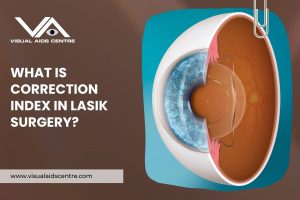Table of Contents
ToggleApproximately 95% of patients experience symptoms of dry eye syndrome for several days or even weeks following surgery.
That number drops to about 60% a month after LASIK, and by 6–12 months post-surgery, most patients recover. Only a small percentage of patients experience persistent symptoms a year after surgery or longer.
For those considering LASIK or already recovering from it, understanding dry eye syndrome (DES) is crucial. While LASIK remains one of the most effective and popular elective surgeries worldwide, its association with temporary eye dryness often raises concerns among patients. Here, we’ll explore why dry eye syndrome occurs after LASIK, how common it is, who is at greater risk, and what can be done to manage and prevent it.
What is Dry Eye Syndrome?
Dry eye syndrome is a medical condition characterised by insufficient tear production or excessive tear evaporation. The result is discomfort, redness, and a gritty sensation in the eyes. While this can happen for many reasons, including ageing and environmental factors, it is particularly common as a temporary side effect of LASIK.
The tear film is integral for eye health and clear vision. It keeps the cornea hydrated, supplies nutrients, removes debris, and protects against infections. LASIK disrupts the corneal nerves responsible for tear production, leading to temporary dry eyes.
Why Does Dry Eye Syndrome Happen After LASIK?
LASIK involves reshaping the cornea using a laser to correct vision problems such as myopia, hyperopia, or astigmatism. During the procedure, a flap is created on the cornea, and this process disrupts the nerves responsible for stimulating tear production. With fewer signals directing the production and distribution of tears, the eyes can become dry.
Factors Contributing to Post-LASIK Dry Eye Syndrome:
1. Nerve Disruption
The corneal nerves play a crucial role in signalling tear production. LASIK severs some of these nerves, affecting their ability to maintain normal tear secretion temporarily.
2. Pre-existing Dry Eye Conditions
Patients with existing dry eye syndrome before surgery are more likely to experience prolonged symptoms afterwards. LASIK can exacerbate pre-existing tear film deficiencies.
3. Flap Thickness
The thickness and depth of the corneal flap created during LASIK can contribute to nerve damage. Thicker flaps may lead to a greater reduction in corneal sensitivity.
4. Age and Hormonal Changes
Older patients, especially postmenopausal women, are at higher risk of developing dry eyes due to reduced tear production linked to hormonal changes.
5. Environmental and Lifestyle Factors
Prolonged screen time, living in a dry climate, or exposure to air conditioning can worsen dryness.
How Common is Dry Eye Syndrome After LASIK?
Initial Symptoms
Nearly every LASIK patient experiences some level of dry eye symptoms after the procedure. Studies estimate that about 95% of patients report mild to moderate dryness during the first few days or weeks while their eyes heal. This occurs due to the aforementioned nerve interruption and reduced tear production.
One Month After Surgery
A significant drop in cases is observed within the first month, with approximately 60% of patients still reporting symptoms. By this point, healing has progressed, and the corneal nerves begin regenerating, partially restoring normal tear production.
Six Months to One Year Later
Within 6–12 months, the vast majority of patients—about 85–90%—find that their symptoms resolve completely. For the remaining few, symptoms can persist, but they are typically mild and manageable with proper treatment.
Beyond One Year
Persistent or chronic symptoms of dry eye syndrome after LASIK are rare. Studies suggest that fewer than 5% of LASIK patients continue to experience severe dryness beyond one year.
Who’s at Risk of Persistent Dry Eye Syndrome?
While most patients recover fully, some are at higher risk of experiencing long-term or severe symptoms. They include:
1. Patients with Pre-existing Dry Eye
LASIK can exacerbate dryness in individuals who already have issues with tear production or quality before surgery.
2. Older Adults
Tear production naturally decreases with age, putting older patients at a higher risk.
3. Women, Particularly Postmenopausal Women
Hormonal changes can reduce tear production, increasing the likelihood of persistent symptoms in women.
4. High Prescription (Myopia or Hyperopia)
Patients who require significant corneal reshaping are more likely to experience nerve disruption and dryness following surgery.
5. Individuals Living in Dry Environments
Environmental factors such as low humidity can make symptoms worse or prolong recovery.
Managing and Treating Post-LASIK Dry Eye Syndrome
Though common, post-LASIK dry eye syndrome is almost always manageable. Eye care professionals recommend a range of treatments depending on the severity of symptoms.
1. Artificial Tears
Over-the-counter artificial tear drops are often the first line of defence. They help lubricate the eyes and relieve dryness. Patients are typically advised to use preservative-free artificial tears frequently during the first few weeks post-surgery.
2. Prescription Eye Drops
For more severe cases, doctors may prescribe anti-inflammatory eye drops like cyclosporine (Restasis) or lifitegrast (Xiidra) to reduce inflammation and improve tear production.
3. Punctal Plugs
Punctal plugs are small devices inserted into the tear ducts to block drainage, retaining more natural tears on the eye’s surface. This treatment is particularly beneficial for patients with prolonged symptoms.
4. Omega-3 Fatty Acids
Dietary supplements of omega-3 fatty acids have been shown to improve tear quality and reduce inflammation. Foods like salmon, walnuts, and flaxseeds are also great natural sources.
5. Environmental Adjustments
Adjusting lifestyle habits and surroundings can significantly improve symptoms. Simple changes include using a humidifier, reducing screen time, and wearing protective eyewear outdoors.
6. Eyelid Hygiene
Cleaning the eyelid margins can help remove debris and bacteria that block the meibomian glands, one of the major contributors to dry eyes.
Prevention Strategies for Prospective LASIK Patients
Taking preventive measures before undergoing LASIK can reduce the likelihood and severity of dry eye syndrome.
1. Pre-surgical Evaluation
It’s essential to undergo a thorough pre-operative assessment with your ophthalmologist. If you’re prone to dryness, they may recommend alternative procedures or treatments to stabilise the tear film before surgery.
2. Lubrication Therapy
Pre-treating the eyes with artificial tears or medicated eye drops before surgery can improve tear film stability.
3. Choosing the Right Procedure
Instead of LASIK, some patients opt for other refractive surgeries like SMILE (small incision lenticule extraction) or PRK (photorefractive keratectomy), which have a lower risk of dry eye symptoms.
4. Follow Post-Operative Instructions
Following your doctor’s post-surgery care plan, including regular use of lubricating drops, will support healing and comfort.
When to Speak to Your Doctor
If dry eye symptoms persist or intensify beyond what’s considered normal, reach out to your doctor. Warning signs include severe pain, blurry vision that doesn’t improve with blinking or excessive redness.
Summing Up
Dry eye syndrome is a common post-LASIK phenomenon, but for most patients, it’s temporary and resolves within a year. Understanding the causes, prevention strategies, and available treatments can make the recovery process smoother and less worrisome.
If you’re considering LASIK or are already recovering, remember that proactive care and guidance from an experienced ophthalmologist will ensure the best possible outcomes. By arming yourself with knowledge and following preventive measures, you can look forward to clearer, sharper vision—without the lingering discomfort of dry eyes.













